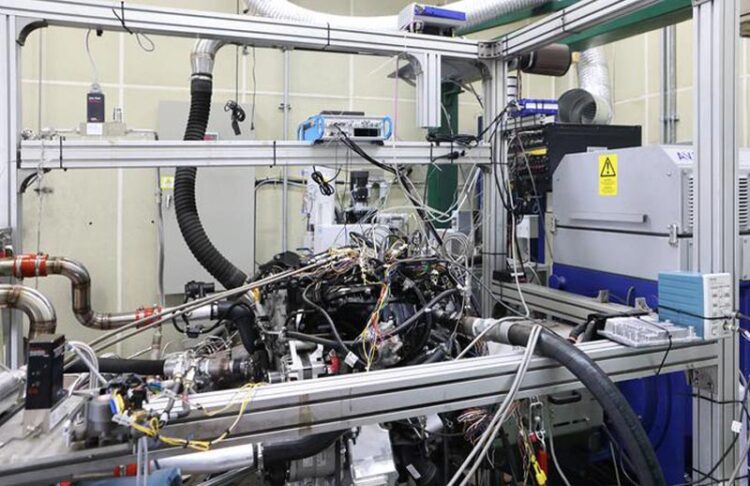Era of hydrogen-fueled vehicles to begin

Hydrogen engine test and development
Credit: Korea Institute of Machinery and Materials (KIMM)
World-class technology technology for a 2-liter class hydrogen engine (or a passenger car hydrogen engine) capable of running entirely on hydrogen has been developed for the first time in the country.
Emissions of carbon dioxide and fine dust reduced by 99% and 90%, respectively.
Amid the fierce competition throughout the globe to develop hydrogen mobility technologies to achieve carbon neutrality, a new technology for a 2-liter class hydrogen-fueled engine (a passenger car hydrogen engine) capable of running entirely on hydrogen has been developed for the first time in the country.
The joint research team led by Principal Researcher Young Choi of the Department of Mobility Power Research of the Korea Institute of Machinery and Materials (President Sang-jin Park, hereinafter referred to as KIMM), an institute under the jurisdiction of the Ministry of Science and ICT, and Researcher Hong-gil Baek of the Zero-Carbon Engine Research Lab of Hyundai-Kia Motor Company (Chairman Eui-sun Chung, hereinafter referred to as HMC) developed the “direct injection hydrogen engine” that runs entirely on hydrogen fuels, and demonstrated its world-class excellence through performance evaluation.
The joint research team of KIMM and HMC injected hydrogen directly into the combustion chamber of the engine of HMC’s existing hybrid vehicle, with a pressure larger by more than 30 times than atmospheric pressure (or with a pressure of more than 30 bar). By using a turbo charger that improves the performance of the engine, the research team was able to maintain high thermal efficiency in all domains from the ignition of the engine to the upper limit of the engine load, allowing the engine to be stably operated throughout the entire engine operating conditions.
In the case of conventional “port injection engines*,” the amount of air that flows into the combustion chamber declines because of the space taken up by the hydrogen fuel that exists in a gaseous state, which leads to lower fuel efficiency and poorer engine performance due to the backfire of the hydrogen fuel and air.
* Port injection hydrogen engine: A port injection hydrogen engine is a type of internal-combustion engine that uses hydrogen as fuel, and combusts hydrogen after mixing it with air by injecting hydrogen using an upper inhaling port instead of injecting it into the cylinder.
On the other hand, the “direct injection hydrogen engine” newly developed by the joint research team has fundamentally resolved the issue of backfire by injecting high-pressure hydrogen fuel directly into the combustion chamber. At the same time, the high compression ratio, fuel stratification, and ultra-lean combustion help to maximize thermal efficiency and improve power performance, while at the same time reducing the amount of harmful emissions.
Compared with gasoline engines, the newly developed hydrogen engine helps to reduce the emissions of carbon dioxide and fine dust by 99 percent and 90 percent, respectively, which meets EU (or European Union)’s requirements for zero-emission vehicles. Additionally, the hydrogen engine emits nitrogen oxides* of less than 15 ppm even without an aftertreatment system that purifies exhaust gases, achieving a high thermal efficiency of up to 40 percent.
* Nitrogen oxides: Nitrogen oxides are chemicals that are created through the reaction between nitrogen and oxygen, and are usually generated during the combustion process of vehicle engines and power plants, etc. Nitrogen oxides are considered to be harmful to the environment, and high emissions of nitrogen oxides may lead to health problems related to respiratory diseases.
Principal Researcher Young Choi of the Department of Mobility Power Research of KIMM said, “The newly developed hydrogen engine technology is an instantaneous and economical technology that can help to replace fossil fuels, which are currently being used as the main power source for vehicles, with carbon-free hydrogen fuels.” He added, “Through collaboration with HMC, we will verify the durability of the engine and also expand the application of this technology to not only passenger vehicles but also commercial vehicles and electricity generation power units. Through continuous research and development of technologies for generating power using carbon-free fuels, we will take the lead in the realization of carbon neutrality.”
The Korea Institute of Machinery and Materials (KIMM) is a non-profit government-funded research institute under the Ministry of Science and ICT. Since its foundation in 1976, KIMM is contributing to economic growth of the nation by performing R&D on key technologies in machinery and materials, conducting reliability test evaluation, and commercializing the developed products and technologies.
This research was carried out with the support of the project for the “development of liquid hydrogen engines for running drones and robots,” one of KIMM’s basic projects, as well as the project for the “evaluation of hydrogen direct injection engines” supported by HMC.
All latest news from the category: Automotive Engineering
Automotive Engineering highlights issues related to automobile manufacturing – including vehicle parts and accessories – and the environmental impact and safety of automotive products, production facilities and manufacturing processes.
innovations-report offers stimulating reports and articles on a variety of topics ranging from automobile fuel cells, hybrid technologies, energy saving vehicles and carbon particle filters to engine and brake technologies, driving safety and assistance systems.
Newest articles

First-of-its-kind study uses remote sensing to monitor plastic debris in rivers and lakes
Remote sensing creates a cost-effective solution to monitoring plastic pollution. A first-of-its-kind study from researchers at the University of Minnesota Twin Cities shows how remote sensing can help monitor and…

Laser-based artificial neuron mimics nerve cell functions at lightning speed
With a processing speed a billion times faster than nature, chip-based laser neuron could help advance AI tasks such as pattern recognition and sequence prediction. Researchers have developed a laser-based…

Optimising the processing of plastic waste
Just one look in the yellow bin reveals a colourful jumble of different types of plastic. However, the purer and more uniform plastic waste is, the easier it is to…



